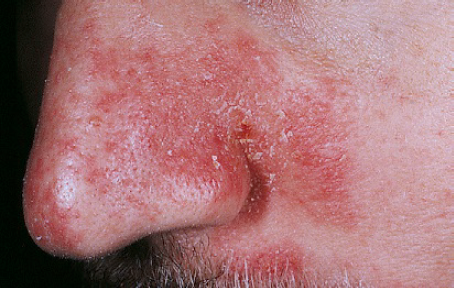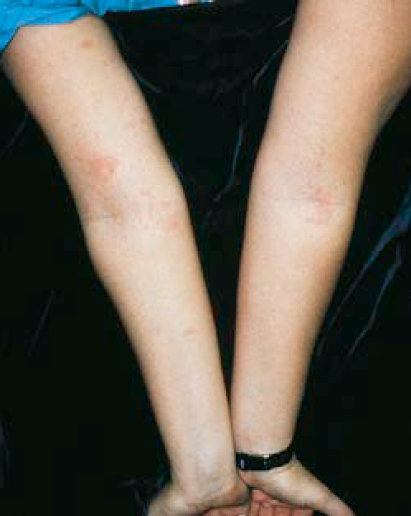Dermatitis
Content of This Page
1- Introduction
2- Causes
3- Symptoms
4- Stages of The Disease
5- Treatment
6- What Should You Avoid
Introduction
Dermatitis is a general term for inflammation of the skin that causes redness, itching, and swelling. It can affect various parts of the body and is often triggered by factors like irritants, allergens, or underlying health conditions. Common types include eczema (atopic dermatitis), contact dermatitis, and seborrheic dermatitis.

Causes
- Irritants: Such as harsh soaps, chemicals, or frequent hand washing.
- Allergens: Like certain foods, pollen, or pet dander.
- Genetics: Family history of dermatitis or other allergic conditions.
- Environmental Factors: Extreme temperatures, humidity, or exposure to sunlight.
- Microbial Infections: Fungal or bacterial infections.
- Stress: Emotional or physical stress can trigger or worsen symptoms.
- Underlying Health Conditions: Conditions like autoimmune disorders or hormonal changes.
Symptoms
- Redness: Areas of skin become red and inflamed.
- Itching: Persistent itching or discomfort.
- Swelling: The affected skin may swell.
- Dryness: Skin may become dry, scaly, or flaky.
- Rashes: Rash may appear as patches, bumps, or blisters.
- Crusting or Oozing: In severe cases, the skin may develop crusts or ooze.
- Thickened Skin: Chronic dermatitis can cause the skin to thicken and become leathery.

Stages of The Disease
Acute Stage:
- Symptoms: Redness, swelling, and itching. Skin may be moist or weepy with blisters or oozing.
- Description: The initial reaction to an irritant or allergen, characterized by rapid onset of symptoms.
Subacute Stage:
- Symptoms: Reduced redness but still itchy. Skin may begin to dry out and flake.
- Description: Symptoms start to improve but can persist with dryness and scaling.
Chronic Stage:
- Symptoms: Persistent redness, thickened skin, and severe itching. Skin may be dry and scaly, with possible thickening (lichenification).
- Description: Long-term dermatitis that can lead to more pronounced skin changes and potential scarring.
Remission:
- Symptoms: Reduced or absent symptoms if properly managed.
- Description: Periods where symptoms improve significantly or disappear, though flare-ups can still occur.
Treatment
Topical Treatments:
- Corticosteroids: To reduce inflammation and itching.
- Topical Calcineurin Inhibitors: Such as tacrolimus or pimecrolimus for sensitive areas.
- Emollients: Moisturizers to hydrate and protect the skin.
Oral Medications:
- Antihistamines: To relieve itching and allergic reactions.
- Oral Corticosteroids: For severe inflammation, usually for a short period.
Avoiding Triggers:
- Identifying and Avoiding Irritants: Such as harsh soaps or allergens.
- Using Gentle Skin Products: Mild, fragrance-free cleansers and moisturizers.
Lifestyle Adjustments:
- Moisturizing Regularly: To prevent dryness and maintain skin barrier function.
- Managing Stress: As stress can exacerbate symptoms.
Procedural Treatments:
- Phototherapy: Using ultraviolet light for severe cases.
- Wet Dressings: To soothe inflamed skin and enhance absorption of topical treatments.
Infection Management:
- Antibiotics or Antifungals: If a secondary infection is present.
Education and Support:
- Patient Education: Learning how to manage triggers and symptoms effectively.
What Should You Avoid
- Harsh Soaps and Detergents: Products with strong chemicals or fragrances.
- Scratching or Rubbing: This can worsen irritation and lead to infection.
- Known Triggers: Such as allergens, irritants, or certain fabrics.
- Excessive Heat or Cold: Extreme temperatures can exacerbate symptoms.
- Overuse of Topical Steroids: Follow medical guidance to avoid side effects.
- Stress: Stress can trigger or worsen symptoms.
- Drying Products: Like alcohol-based lotions or astringents.
- Ignoring Moisturization: Skipping regular use of emollients can lead to dryness.